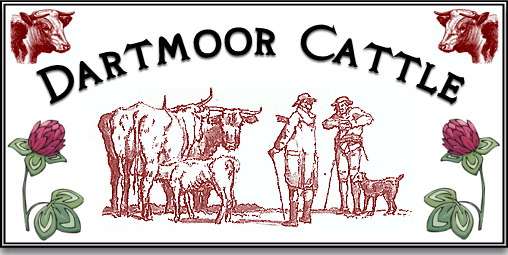
The extensive Bronze Age reave system on Dartmoor is testament to how long cattle have been grazing the moor. When a mans wealth was measured by the number of cattle he owned it was therefore important to stock and control the animals, hence the enclosures created by the reaves. There are two types of grazing on Dartmoor, there are the commoners rights and venville rights. The commoners grazing rights basically mean than anyone living within the Forest of Dartmoor has the right of agistment or depasturage on the moor. This meant that within certain limitations they could graze their cattle on the moor by licence of the Duchy of Cornwall.
There were 24 parishes that encompassed the forest of Dartmoor and it was the inhabitants of these parishes that held venville rights. For those that held them it meant they could pasture cattle on the moor as long as they paid a fee to the agisters or moormen for the relevant moor quarter, these were called ‘Fin ville’ or ‘fyne de ville’ which is where the term venville comes from. Those who pay the venville are known as Venvill Men’. These rights were granted in 1392 and originally meant that animals could be grazed on the moor from sun up to sun down, any animal found outside these times would be ‘pounded‘ and the owner had to pay to get them back. The other obligation the venville men had was to attend the annual drifts, this was where the moor were driven and any cattle that were illegally pastured were taken to the relevant pounds where they would wait to be claimed by their owners.
In historical times the 70,000 acres of moorland were divided into quarters, North, South, West and East. These quarters would be rented by ‘agisters’ or ‘moormen’ who would then organise the grazing and welfare of the cattle in his charge or sub-let parcels of land. The farmers who owned the cattle would then pay a fee to the agister for his services. The practice of pasturing cattle on the moor was known as ‘agistment‘.
For grazing purposes the high rainfall and the moisture holding properties of the peaty soil have meant that in dry summers when the lowland grazing would have dried, up the moorland grasses continue to grow and provide fodder for the cattle. Two of the commoner types of grass to be found growing on the moor are molinia caerulea or ‘flying bent’, more locally known as ‘sedge grass’, and nardus stricta or ‘mat grass’. The flying bent is a flat -bladed grass which grows in tussocks. From May to July it sends up long, spiky green leaves which the cattle readily graze. the mat grass is not liked by the cattle and is usually left to the ponies to eat.
Therefore every summer huge numbers of cows would be brought up from the ‘down country’ to graze the newtakes and moors. When the cattle were being moved onto or off the moor it was described as the ‘Red Tide‘ because most of the cattle were of a red colour and there were so many of them in the droves. In June the agisters from the four quarters would arrange collection points from where the cattle would be driven onto the moor. The eastern quarter would collect the beasts at Bovey Tracy on the first Friday of the month, the collection point later moved to Five Wyches Farm and then to the top of Green lane on the edge of the moor. As many as 200 cattle would be assembled and then driven up to Runnage farm. The next day more cattle would be gathered on Denbury Green and these too would be taken up to Runnage, again numbers varied from 200-300 head. Sunday was the ‘lords day’ but on Monday bullocks would be collected from Buckfastleigh and taken to Runnage. Once the animals reached Runnage their individual farm earmarks or brandings were recorded and then they were driven into a small pound where they would get their ‘quarter mark’. For the eastern quarter this would be three straight marks cut onto the horn with a ‘corning’ or ‘carning’ saw. The animals would then be released onto the moor where they would spend the next six months.
The southern quarter would collect most of their cattle from the village of Moorleigh, although a few were gathered from Bovey Tracy. Again the cattle would be recorded and quarter marked, this time by cutting the hair at the bottom of the tail in a ring and turned onto the moor. There are stories that once the drove reached Diptford the cattle would be left to wander down the lane whilst the drovers stopped at the local inn. The older bullocks who had made the trip several times would lead the rest to the moor gate. Once the men had had their tipple they would head off down the lane and collect any stragglers on their way.
The northern quarter did things slightly differently, the farmers would quarter mark their own cattle and then drive them up to Creber Pound where they would be turned out onto the moor. The northern quarter mark was two saw marks on the tip of the horn.
The western quarter had no specific collecting point but their quarter mark was a ‘W’ branded onto the horn.
This practice had gone on for centuries and there is a document showing that in 1342-3 there were 9,750 cattle lodged on the moor, in 1597 there were 10,356 head of cattle on the moor. Early in the 1900’s it was estimated that about 1,000 – 1,200 head of cattle were agisted on the eastern quarter.
Most of the cattle would be left on the moors until the end of September or early November, the hardier Scotch Cattle would stay a lot longer, probably until Christmas. Once on the moor the animals would be regularly checked by the agisters or the moormen, usually about three times a week. If they found any missing it was their duty to find the strays and return them to where they should be. Cattle and sheep tend to graze in the same areas, usually because the grass is more abundant than else where, these are called ‘lairs‘. So, even though they may have many hundreds of animals in their care it isn’t usually too hard to locate them. Occasionally there were the more adventurous bullocks who would stray further, one report is of an animal that went from Walkham head and was found on Bodmin moor, which as the crow flies is about 30 miles. The practice of taking cattle up to the moor has now died off due partly to the military use of the moor and the amount of traffic on the roads. What must have been one of the last big movements of cattle took place in 1944 when 800 bullocks were driven off the southern quarter.
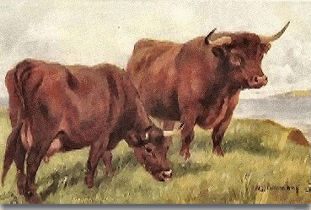
Vancouver, in his ‘General View of Agriculture in Devon’ describes the local breed as being a cross between the North Devon and the Old Marlborough Red which he considers originated from South Molton. This cross-breed, later known as the ‘Devon Red’ or ‘Ruby Red’ was thought to have a, “greater aptitude to fatten out in a given time and produce a greater offal”. They were said to make good plough oxen that were, “gentle in the harness”, but not quite so, “hardy in the performance of its labour”, as other breeds. It was reported that in the early 1800’s a farmer living in the parish of Ashburton had a cow whose milk, after calving, produced 3lbs 1oz of butter daily. Another cow in the same herd produced 24 quarts of milk per day (6 gallons) which again in turn yielded 2lbs 8oz of butter. Which when considering that the intensive milk production of today would average out at around 9 gallons a day was bad for 200 years ago, In 1851 a breeder from near South Molton, Lt. Col. John Tanner Davey began to record his herd and this went on to the formation of the Devon Cattle Breeders Society in 1851. Ever since the society has striven to maintain the purity of the breed and promote its many benefits.
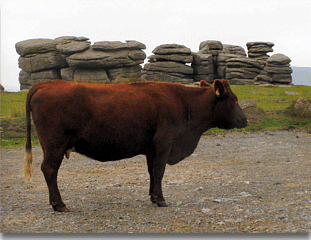
Devon Red Breed
The other breed of cattle seen on the moor was and is the South Devon. This is said to be the largest of the British native breeds and is often known as the ‘Gentle Giants’. It is large farmed with good muscular conformation and matures early in terms of puberty but late in terms of fat deposits. Coulor-wise it tends to be a rich, medium red with copper tints and has thick, loose, mellow skin. The breed is also famed for its excellent temperament, I have had occasions to inject fully grown bulls whilst it stood in the yard, no cattle crush or restraint was needed. South Devon’s are excellent converters of roughage giving modern milk yields of 700 – 1,000 gallons of milk per lactation, they are said to have a large belly capable of coping with coarse moorland grasses. They also have a thick, curly winter coat which is ideally suited to the Dartmoor winters. The milk is of excellent quality and it has been estimated that two gallons of their milk will give a pound of butter or two pound of cheese. I can also recall an occasion when a heavily pregnant cow got firmly stuck in the shippen passageway. It must have taken a good hour of pushing and heaving to extricate the poor thing, but all through her ordeal the cow remained calm and good tempered, which is more than could be said for us. If you can detect a hint of favouritism then you are dead right as this is my favourite breed of cattle and to see a young South Devon calf has to be one of the most heart warming sites possible. There is nothing nicer than to offer a finger and watch the big doughy eyed creature suck and slurp on it, and the smell of a new calf must rank along that of a field of newly cut hay. Having got very sentimental about South Devon cattle there is one other delight they provide and that is a fillet steak, believe me you haven’t lived until you have had such a feast.
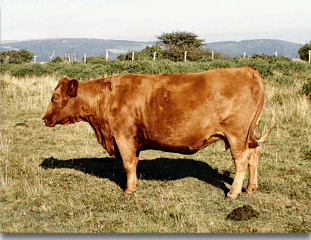
South Devon Breed
There are still some Devon Reds and South Devons kept on Holne Moor and are a splendid sight on a summer’s day as the sun lights up their red coats. Probably the most common breed to be seen on the moor today is the Welsh Black crosses. These are noted for their hardiness and ability to graze the rougher pastures, so much so that rough, reedy pasture is was often called ‘black bullock land’. On hot days it is sometimes possible to get an insight into their temperament which to say the least is not one of tolerance. I can remember being chased up on Manga Hill by a very tetchy black bull. Luckily it did not follow me into the nearby bog which saved us both a great deal of energy.
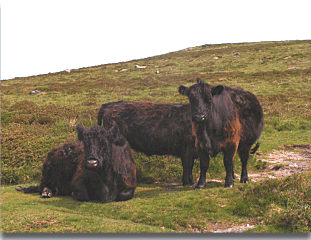
Welsh Black x Breed
The other common moorland breed is the Belted Galloway, again these animals are well suited to the harsh environment of the moor. They are very distinctive beasts with their white ‘belt’ wrapped around the middles. Again these can be very lively beasts, it is the only breed of cattle that I have ever seen turn 360º in a cattle crush. I will always remember that occasion as I still have a lump on my finger from the dose of Blackleg Vaccine I mistakenly received whilst trying to inject the ‘spinning’ bullock. The only plus point of that exercise was that according to the manufacturers of said vaccine I will never need another tetanus injection in my life – moo, bloody moo! The other thing about these and other moorland cattle is that once they decide to go somewhere they go there. A friend was once driving along a high banked moorland road when two black bullocks suddenly appeared from above the bank and clattered down onto the bonnet of his car. The bullocks were a bit shaken but soon recovered to continue on their urgent mission, sadly said friend couldn’t as the plumes of steam rising from his crumpled bonnet testified. Looked bloody good on his insurance claim, name and address of co-claimant – Billy Bullock, Dartmoor!

Belted Galloway Breed
The other breed that occurs mainly around the Belstone Common area are the Highland Cattle. Once again these are well suited to the Dartmoor climate but I would politely venture to suggest that these are kept as more of a hobby than a true business venture. There used to also be a herd that grazed the Dartmoor Prison fields at Princetown but I am not sure if they are still there, certainly I haven’t seen them for a while, but could be wrong.
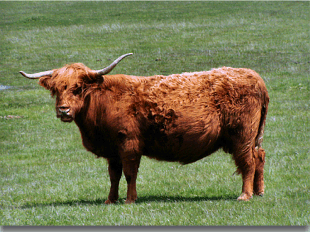
Highland Cattle Breed
Whenever ‘walking with cows’ it is always best to show caution, for further detail please click – HERE
 Legendary Dartmoor The many aspects past and present of Dartmoor
Legendary Dartmoor The many aspects past and present of Dartmoor
